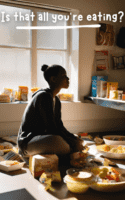Watching the latest season of Heartstopper on Netflix brought back memories of a time when I couldn’t bear to look at food. Reading the graphic novel that inspired the show many years ago, I saw my struggles portrayed with such compassion in drawings and words that it moved me to tears. I could never call it an eating disorder because I was never diagnosed with it and words have power. I resorted to saying ‘I have a terrible relationship with food,’ and left it there. It was true.
As I type this, I am having my second cup of coffee and a bowl of crisps. This is my second meal of the day. Don’t ask me what my first meal was because you’re most likely to gasp. My friends sure do. This will bide me until whenever I decide that I feel like having something in my stomach. As a jobless twenty-something living at home, I don’t think about food as much as I’m told I should, which made me realise that I’m still grappling with these issues. Many people, especially young Black people and their families, do not know what eating disorders are and how to tackle them. They are often dismissed as picky or moody eaters in many other cases. But before I can even speak about this information gap and what causes it, it’s essential to explain what eating disorders are and how we can deal with them.
What is an eating disorder?
Eating disorders are behavioural conditions that are characterised by severe and recurring disturbances in how one eats and relates to food. This is often associated with distressing thoughts or emotions, and can seriously affect a person’s physical, psychological and social wellbeing. Since there are different kinds of eating disorders—like bulimia, anorexia, binge eating disorder, avoidant restrictive food intake disorder among others—that means, there are just as many different causes and treatments for them.
I was in my final year of undergrad when I realised that I have a disordered relationship with food. When I was researching this, I questioned what relationship food disorders have with food insecurity and growing up poor. I asked my friends if this was something that happened often because when I was in high school I went through a phase of hoarding food, and would later discover that my side of the disordered eating coin was leaning towards anorexia nervosa. I resisted this label because it’s often associated with fear of weight gain and body image issues, neither of which fully applied to me. I simply harboured guilt and shame whenever I touched food. Over time this guilt turned into disinterest and a low tolerance for food. I find eating, the entire concept of mastication, so laborious, that I often joke to my friends that I would accept it if it were fed to me intravenously. That’s cause for concern, no?
Before Heartstopper, I had not seen the condition being depicted as such. As much as it is prevalent, especially in young gay or queer individuals, male eating disorders are rarely ever spoken about or researched. Disordered eating patterns can be caused by feelings of concern about body weight and shape, and I know many gay boys who feel a certain way about their bodies and have had these tendencies translate to how they view food.
How do you know when someone has an eating disorder?
Eating disorders manifest differently depending on the individual and type involved. Common signs include significant weight gain or loss, having an irrational fear of gaining weight, a fixation on dieting, and rigid eating patterns. Social withdrawal can result from an eating disorder but also serves as a symptom since it disrupts a person’s emotional and social well-being.
Can it be helped?
Since eating disorders normally occur with other mental illnesses like anxiety, obsessive-compulsive disorder, and depression, to name a few, they are perfectly treatable. It requires the person to seek help so they can be diagnosed in time and treated accordingly since they can often lead to other physical complications in one’s digestive system, heart conditions, and even liver failure. In many fatal cases, an eating disorder may lead to suicide. When dealt with accordingly and timeously, a comprehensive treatment plan consisting of therapy and nutritional counseling, medical care, and professional interventions, can ensure that the person has a more positive outcome.
It is a journey, and one that can be helped. Reflecting on it makes me realise that the answer is not solid or fool-proof, but very much ongoing and deeply personal. Heartstopper resonated with me because it showed me the complexities of these experiences and the kindness needed to effectively deal with them, especially for young people navigating their identities.
By speaking out about our problems and seeking information and help, we can obliterate the stigma surrounding it. We can help those who may be silently battling this issue and don’t readily have the knowledge to be discerning and ask for help.
****
At Fundza, we value a positive, respectful, and inclusive community where everyone feels safe to share their thoughts. Please remember to keep your comments friendly, constructive, and free from any form of hate speech, bullying, or discrimination. Any comments containing offensive language, personal attacks, or harmful content will be removed, and repeat offenders may be banned. Additionally, do not share personal information about yourself or others. This includes but is not limited to, phone numbers, addresses, or any other private information. Let’s keep the conversation welcoming, safe, and supportive for all!





